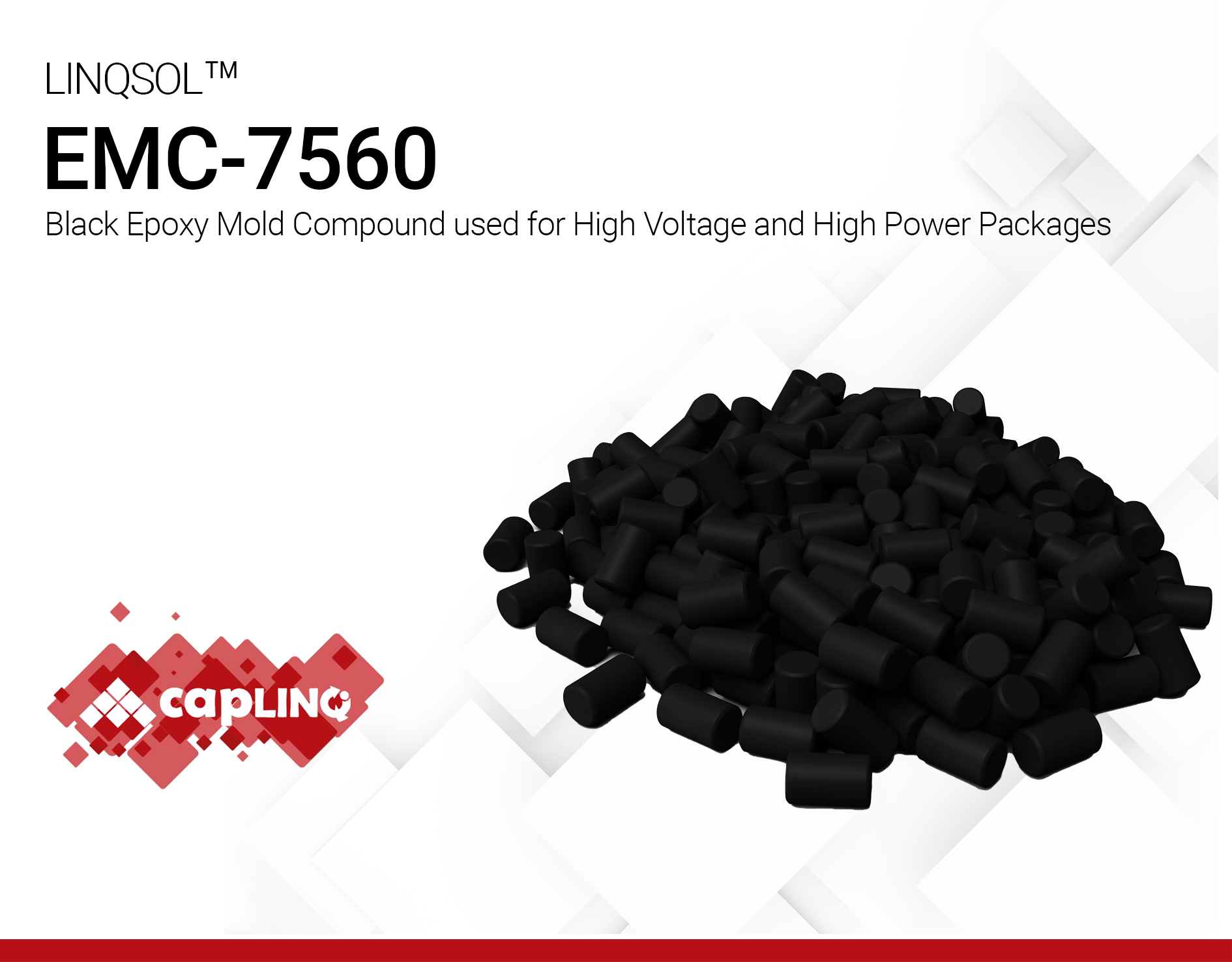LINQSOL EMC-7560 | Black Epoxy Mold Compound
- High Glass Transition Temperature (205 °C)
- Designed for high voltage, high power discrete packages
- New Epoxy System To Pass HTRB Tests
Product Description
LINQSOL EMC-7560 is a black, halogen-free epoxy molding compound designed for high-voltage and high-temperature semiconductor applications. It adopts a multifunctional epoxy system with a hydrophobic hardener and a new type of stress modifier that utilizes a super dispersion technology. With a high glass transition temperature (Tg = 205 °C), low coefficient of thermal expansion (CTE), and low modulus, EMC-7560 ensures robust performance. EMC-7560 boasts low moisture absorption (<0.1%) and minimal mold shrinkage, improving reliability. It has a UL 94 V-0 flammability rating, highlighting its adherence to stringent safety standards for high-power semiconductor applications.
LINQSOL EMC-7560 finds its niche in high-voltage and high-power discrete packages, including but not limited to TO220, TO247, and other surface mount devices. It enables SiC power modules to pass and perform well in H(3)TRB, HTGB, and HTOL tests. Its innovative epoxy system, which features a high-density molecule matrix, minimizes ion diffusion, ensuring enhanced reliability and superior performance in challenging HTRB and H3TRB conditions. This material has a CTI of 600V.
Key Features:
- High temperature stability with high Tg (205 °C)
- Excellent electrical stability due to low ion content and mobility
- Low stress with low CTE (10 ppm) and low modulus
- Low moisture absorption and low mold shrinkage (<0.1%)
- Halogen-free (does not contain Br, Sb, P)
- UL 94 V-0 Flammability
Application: SiC MOSFETs; TO-package Devices
Technical Specifications
| General Properties | |
| Color Color The color | black |
| Filler Content | 85 % |
| Specific Gravity Specific Gravity Specific gravity (SG) is the ratio of the density of a substance to the density of a reference substance; equivalently, it is the ratio of the mass of a substance to the mass of a reference substance for the same given volume. For liquids, the reference substance is almost always water (1), while for gases, it is air (1.18) at room temperature. Specific gravity is unitless. | 1.95 |
| Chemical Properties | |
| Moisture absorption | 0.4 % |
| Physical Properties | |
| Spiral Flow @ 175°C | 82 cm |
| Thermal Properties | |
| Glass Transition Temperature (Tg) Glass Transition Temperature (Tg) The glass transition temperature for organic adhesives is a temperature region where the polymers change from glassy and brittle to soft and rubbery. Increasing the temperature further continues the softening process as the viscosity drops too. Temperatures between the glass transition temperature and below the decomposition point of the adhesive are the best region for bonding. The glass-transition temperature Tg of a material characterizes the range of temperatures over which this glass transition occurs. | 205 °C |
| Thermal Conductivity Thermal Conductivity Thermal conductivity describes the ability of a material to conduct heat. It is required by power packages in order to dissipate heat and maintain stable electrical performance. Thermal conductivity units are [W/(m K)] in the SI system and [Btu/(hr ft °F)] in the Imperial system. | 0.9 W/m.K |
| UL 94 Rating UL 94 Rating Flammability rating classification. It determines how fast a material burns or extinguishes once it is ignited. HB: slow burning on a horizontal specimen; burning rate less than 76 mm/min for thickness less than 3 mm or burning stops before 100 mm V-2: burning stops within 30 seconds on a vertical specimen; drips of flaming particles are allowed. V-1: burning stops within 30 seconds on a vertical specimen; drips of particles allowed as long as they are not inflamed. V-0: burning stops within 10 seconds on a vertical specimen; drips of particles allowed as long as they are not inflamed. 5VB: burning stops within 60 seconds on a vertical specimen; no drips allowed; plaque specimens may develop a hole. 5VA: burning stops within 60 seconds on a vertical specimen; no drips allowed; plaque specimens may not develop a hole | V-0 |
| Mechanical Properties | |
| Molded Shrinkage | 0.1 % |




